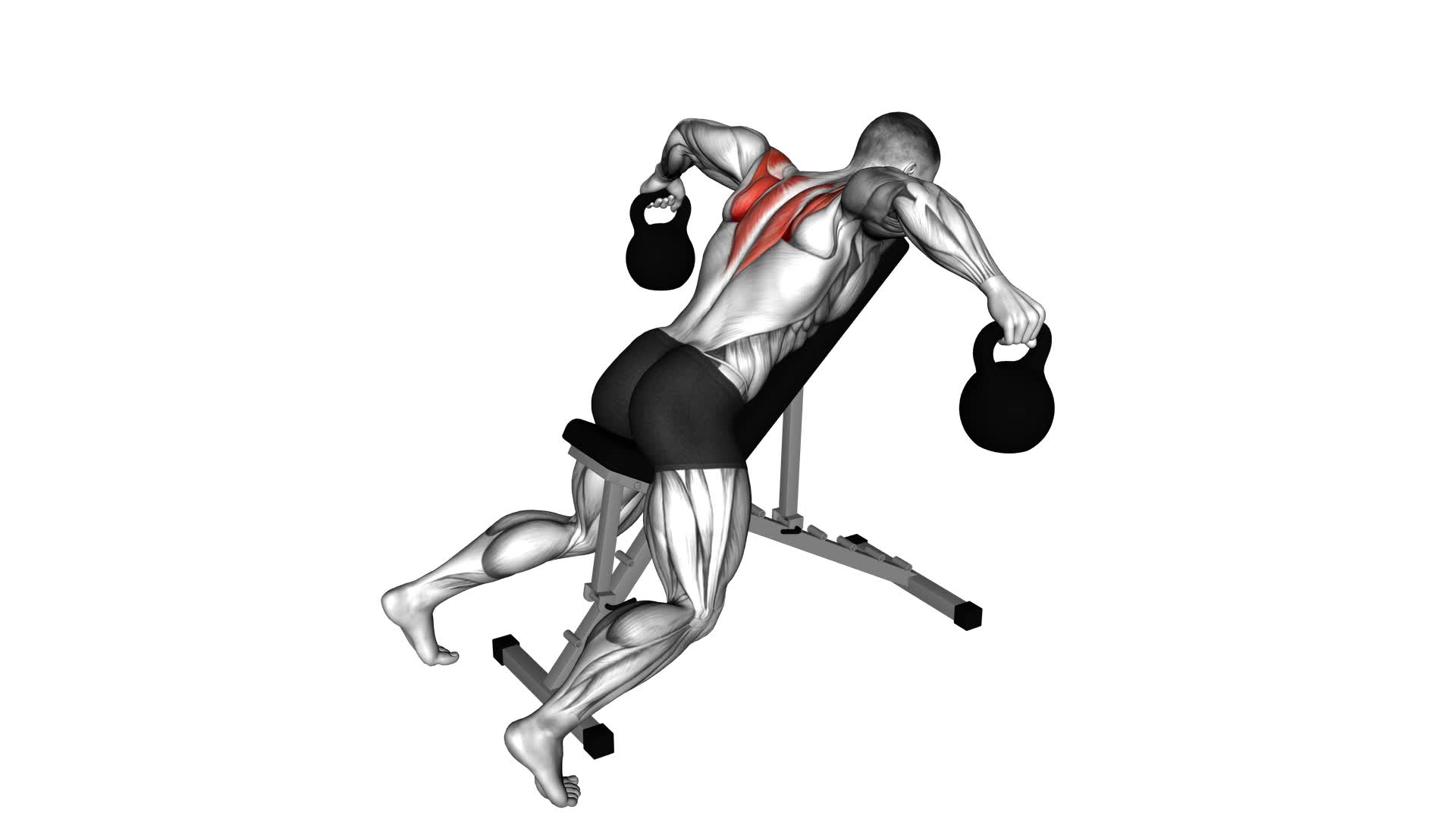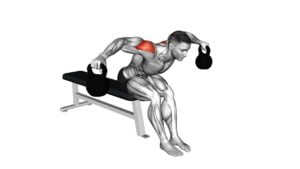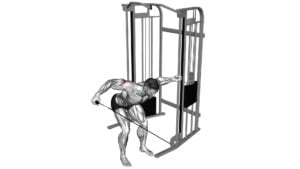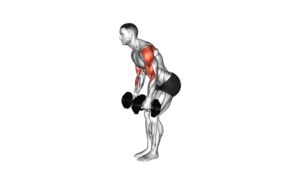Kettlebell Reverse Fly – Video Exercise Guide & Tips

Looking to tone and strengthen your upper body? The Kettlebell Reverse Fly is a fantastic exercise that targets your back, shoulders, and arms. In this video exercise guide, we'll show you the proper form and technique to get the most out of this exercise.
Watch This Exercise Video
You'll also learn how to choose the right kettlebell weight and avoid common mistakes. Follow our step-by-step guide and discover valuable tips for maximizing your results.
Let's get started!
Key Takeaways
- Proper form and technique are essential for performing the kettlebell reverse fly.
- Engaging the core is important for stability and injury prevention.
- The exercise strengthens upper back muscles, improves posture, and enhances upper body strength.
- Choosing the right kettlebell weight is crucial for maintaining proper form and preventing injury.
Proper Form and Technique
To ensure proper form and technique for the kettlebell reverse fly, keep your shoulders relaxed and engage your core throughout the exercise. This is crucial to prevent unnecessary strain on your muscles and to maximize the effectiveness of the movement. One of the most common errors people make is allowing their shoulders to tense up, which can lead to discomfort and incorrect alignment. By consciously keeping your shoulders relaxed, you allow the focus to be on your upper back, where the exercise targets the muscles responsible for posture and shoulder stability.
Engaging your core is also essential during the kettlebell reverse fly. This helps to maintain stability and control throughout the movement. By keeping your core activated, you create a solid foundation for your upper body and prevent any excessive swaying or arching of the back. This not only enhances the effectiveness of the exercise but also reduces the risk of injury.
The benefits of performing the kettlebell reverse fly with proper form and technique are numerous. It helps to strengthen the muscles of the upper back, including the rhomboids, trapezius, and rear deltoids. This, in turn, improves posture, shoulder stability, and overall upper body strength. Additionally, engaging your core throughout the exercise adds an extra challenge and helps to strengthen your abdominal muscles.
There are a few variations of the kettlebell reverse fly that you can incorporate into your workout routine. One option is to perform the exercise while standing, which adds an element of balance and stability. Another variation is to use a heavier kettlebell for increased resistance, or to perform the exercise on an unstable surface, such as a balance board or Bosu ball, to challenge your stability even further.
Choosing the Right Kettlebell Weight
When selecting the appropriate kettlebell weight, consider your current strength and fitness level, building upon the proper form and technique discussed previously. Kettlebell weight selection is crucial to prevent injuries and ensure an effective workout.
Choosing a weight that's too heavy can strain your muscles and increase the risk of injury, while a weight that's too light may not provide enough resistance to challenge your muscles and produce results. It's recommended to start with a lighter weight and gradually increase as your strength improves.
A good rule of thumb is to choose a weight that allows you to perform the exercise with proper form and technique, while still feeling challenged by the last few repetitions. Listen to your body and pay attention to any pain or discomfort during the exercise.
Now that you understand the importance of choosing the right kettlebell weight, let's move on to the step-by-step guide to performing the kettlebell reverse fly.
Step-by-Step Guide to Performing the Kettlebell Reverse Fly
To perform the kettlebell reverse fly, position yourself in a standing position with your feet shoulder-width apart. Hold the kettlebell in front of you with both hands, palms facing towards your body. Engage your core and maintain a slight bend in your knees throughout the exercise.
Begin by hinging at your hips, allowing your upper body to tilt forward. Keep your back straight and your gaze focused on the floor. From this position, slowly lift the kettlebell out to the sides, squeezing your shoulder blades together. Pause for a moment at the top of the movement, and then lower the kettlebell back down with control.
The kettlebell reverse fly is a great exercise for targeting your posterior deltoids, rhomboids, and upper back muscles. It helps improve your posture and upper body strength.
There are variations of the kettlebell reverse fly that you can try to add variety to your workout routine. You can perform the exercise with one arm at a time, alternating between each rep. This challenges your core stability and improves muscle imbalances. Another variation is to perform the exercise while lying face down on a bench, which increases the range of motion and targets your lower back muscles as well.
By following these steps and incorporating variations into your routine, you can maximize the benefits of the kettlebell reverse fly.
Now, let's move on to the next section and discuss common mistakes to avoid when performing this exercise.
Common Mistakes to Avoid
Now let's take a look at some common mistakes you should avoid when performing the kettlebell reverse fly. It's important to be aware of these errors to ensure you get the most out of your workout and minimize the risk of injury.
- Using too much weight: One of the most common mistakes is using a kettlebell that's too heavy. This can lead to poor form and improper execution of the exercise. Start with a lighter weight and gradually increase as your strength improves.
- Rounding the shoulders: Another mistake to avoid is rounding your shoulders during the exercise. This not only reduces the effectiveness of the movement but also puts unnecessary strain on your neck and back. Keep your shoulders pulled back and down throughout the entire motion.
- Swinging the kettlebell: Lastly, avoid swinging the kettlebell instead of using controlled movements. Swinging can lead to jerky motions and increase the risk of injury. Focus on a slow and controlled movement, squeezing your shoulder blades together at the top of the exercise.
Tips for Maximizing Results
To maximize your results with the kettlebell reverse fly, focus on maintaining proper form and incorporating these key tips.
The kettlebell reverse fly is a highly effective exercise that targets the muscles of your upper back, shoulders, and core. By following these tips, you can ensure that you're getting the most out of this exercise.
Firstly, it's important to start with an appropriate weight. Choose a kettlebell that challenges you, but allows you to maintain proper form throughout the exercise. Using a weight that's too heavy can lead to poor form and potential injury.
Secondly, pay close attention to your posture. Keep your back straight and your core engaged throughout the movement. This will help to maximize the activation of your target muscles and protect your lower back.
Additionally, vary your grip to target different muscle groups. By using an overhand grip, you'll primarily engage your upper back muscles. Switching to an underhand grip will shift the focus to your biceps and shoulders.
Finally, consider incorporating variations of the kettlebell reverse fly into your routine. This will help to prevent muscle adaptation and keep your workouts challenging and effective. Some variations include single-arm reverse fly, bent-over reverse fly, and standing reverse fly.
Frequently Asked Questions
How Many Repetitions of the Kettlebell Reverse Fly Should I Do in Each Set?
To determine the ideal repetition range for the kettlebell reverse fly, you need to consider your fitness level and goals.
It's important to maintain proper form throughout the exercise to prevent injury and maximize results.
By starting with a lower number of repetitions, such as 8-10, you can focus on perfecting your technique.
As you progress, gradually increase the number of repetitions to challenge your muscles and promote strength and endurance.
Can the Kettlebell Reverse Fly Exercise Help Improve My Posture?
The kettlebell reverse fly exercise can indeed help improve your posture. By targeting the muscles in your upper back and shoulders, it strengthens the muscles responsible for pulling your shoulders back and keeping your spine in proper alignment.
This exercise also promotes shoulder stability and can help alleviate muscle imbalances that can contribute to poor posture. To get the most out of the exercise, make sure to maintain correct form and engage your core for stability throughout the movement.
Is It Necessary to Warm up Before Performing the Kettlebell Reverse Fly?
Before performing the kettlebell reverse fly, it's important to warm up.
Warming up for kettlebell exercises has several benefits. It helps increase blood flow to the muscles, improves range of motion, and reduces the risk of injury.
By warming up, you prepare your body for the intense workout ahead, allowing you to perform the exercise more effectively.
What Are Some Alternative Exercises That Target Similar Muscle Groups as the Kettlebell Reverse Fly?
If you're looking for alternative exercises that target similar muscle groups as the kettlebell reverse fly, there are a few options you can try.
One option is the bent-over dumbbell fly, which focuses on the rear deltoids and upper back muscles.
Another option is the cable reverse fly, which also targets the rear deltoids and helps improve posture.
Lastly, you can try the resistance band reverse fly, which provides a similar workout and can be done anywhere.
Can the Kettlebell Reverse Fly Exercise Be Modified for Individuals With Shoulder Injuries?
If you have a shoulder injury, modifying the kettlebell reverse fly exercise can help you safely work your shoulder muscles. By using lighter weights or resistance bands, you can reduce strain on your injured shoulder while still benefiting from the exercise.
The kettlebell reverse fly is an effective exercise for strengthening your shoulder muscles, which can improve stability and prevent future injuries. Remember to consult with a healthcare professional or a qualified trainer before attempting any modifications to ensure it's suitable for your specific injury.
Conclusion
In conclusion, the kettlebell reverse fly is a highly effective exercise for strengthening and toning the upper back and shoulders. By maintaining proper form and choosing the appropriate kettlebell weight, you can optimize your results and avoid common mistakes.
Incorporating this exercise into your routine, along with following the tips provided, will help you achieve maximum benefits.
So grab a kettlebell and start reaping the rewards of this challenging yet rewarding exercise.

Author
Years ago, the spark of my life’s passion ignited in my mind the moment I stepped into the local gym for the first time. The inaugural bead of perspiration, the initial endeavor, the very first surge of endorphins, and a sense of pride that washed over me post-workout marked the beginning of my deep-seated interest in strength sports, fitness, and sports nutrition. This very curiosity blossomed rapidly into a profound fascination, propelling me to earn a Master’s degree in Physical Education from the Academy of Physical Education in Krakow, followed by a Sports Manager diploma from the Jagiellonian University. My journey of growth led me to gain more specialized qualifications, such as being a certified personal trainer with a focus on sports dietetics, a lifeguard, and an instructor for wellness and corrective gymnastics. Theoretical knowledge paired seamlessly with practical experience, reinforcing my belief that the transformation of individuals under my guidance was also a reflection of my personal growth. This belief holds true even today. Each day, I strive to push the boundaries and explore new realms. These realms gently elevate me to greater heights. The unique combination of passion for my field and the continuous quest for growth fuels my drive to break new ground.







